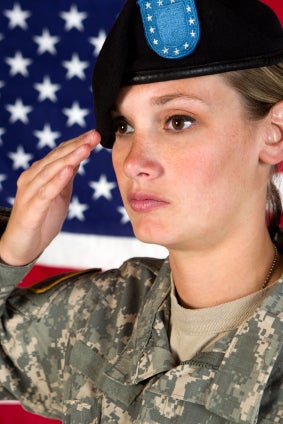
Who we think homeless veterans are, which is no longer an accurate depiction of who they may include (homeless women veterans, with or without dependent children in tow).
A brand new issue of the research journal Psychological Services has come out with an exclusive focus on homelessness, including veteran homelessness. This is great news, because whether or not you’ve been following our recent, multi-part series on female veteran homelessness here, there’s a real need to pay more attention to veteran homelessness and in particular what causes women veterans to be the largest subgroup of homeless veterans today. While we may have a picture in mind of “who a homeless veteran is” as the grizzled guy with his dog, above, it’s no longer an accurate or a comprehensive picture of who homeless veterans are anymore. And given women veterans’ increasing participation in the armed forces, those days are gone and are never coming back.

Women veterans are the fastest-growing demographic of homeless veterans, according to the U.S. Department of Veterans Affairs (VA).
The special issue on homelessness has some very interesting articles in it by some of the key U.S. Department of Veterans Affairs (VA) researchers on veteran homelessness. These have been compelling reading in light of two national surveys I’ve been conducting over the past two years, asking women veterans to talk about their experiences of unstable housing after military service. All told, about 3,000 women veterans have responded to the two surveys, most of whom have also contributed commentaries about their experiences.
All three of the main articles about homeless veterans in the issue underscore the need in different ways for women veterans to be treated as a separate sub-population when understanding how homelessness affects veterans. As the issue’s editor, Jack Tsai, Ph.D. mentioned in a previous article, as recently as five years ago a comprehensive review of the literature identified only two previous studies on homeless female veterans. This is consistent with another observation that “research on homeless veterans typically excludes women” or that “(few studies) have addressed how women came to be homeless.”
In the article by issue editor Jack Tsai, Ph.D., et al. about one-year incidence and predictors of homelessness among 300,000 veterans seen by specialty mental health clinics at VA, it seemed easier to predict the relationships between multiple factors and homelessness — so long as the study subjects were male veterans. Then, drug use, being unmarried, being low-income, being black, having an alcohol use disorder, being aged 46-55, or having a major depressive disorder or dysthymia all were predictive of veteran homelessness. For female veterans in the study, though, only having a drug use disorder (of the factors mentioned) was predictive of homelessness. From other research, we’re aware that other factors — including military sexual trauma (MST), poverty, and other factors are also risk factors for women veterans and homelessness. This dichotomy reinforces the earlier observation from the literature that both more research needs to be done into the causes and manifestations of female veteran homelessness — and also that female veterans appear to be uniquely distinct from their male veteran counterparts when it comes to why they become homeless.
An article by Melissa Dichter, Ph.D., et al. takes a look at intimate partner violence, unhealthy alcohol use and unstable housing among women veterans seen by the Veterans Health Administration (VHA). (Intimate partner violence or IPV is the expanded, up-to-date designation for what we used to call domestic violence, or DV.) Concerningly, the Dichter study pointed out that women veterans face particularly high rates of lifetime IPV exposure — 33 percent of women veterans report IPV vs. 23.8 percent of non-veteran (i.e., civilian) women. Beyond the overlap between IPV and housing instability that exists for both veteran and civilian women, it’s unclear which comes first, the chicken or the egg. In other words, does undergoing intimate partner violence make women more susceptible to unstable housing and/or homelessness — or is it the other way around, do women accept dangerous conditions as way to offset becoming homeless? In both my surveys, I ask women veterans to describe the choices they made to manage periods of unstable or precarious housing, and in their responses, approximately 15 percent indicate staying in unsafe relationships during those times. Clearly, more research is needed into whether women veterans are propelled further into unstable housing because of IPV, or whether unstable housing causes women veterans to accept more dangerous living conditions in order to avoid shelters and the street.
Finally, in the article by Stephen Metraux, Ph.D., et al. about pathways into homelessness among post-9/11-eras veterans, the 17 qualitative interviews conducted were all among male veterans. In the abstract, there’s a sentence that concludes, “We found that veterans predominantly see their homelessness as rooted in non-military, situational factors such as unemployment and the breakup of relationships...” However, to be clear, that would be how the majority of the 17 male veterans in the study saw the connection. When we asked more than 1,500 women veterans a number of questions about unstable housing after their military service, they answered quite differently. More than one-third believed that their military service did affect or contribute to their experiencing unstable housing or homelessness, whether somewhat so or very much so (see following graphic).

When you ask women veterans about their experiences of unstable housing and homelessness, and its connection to their military service.
The upshot is, while it’s very exciting to see more work being done on veteran homelessness, we’re still at a point where research into what causes and contributes to female veteran homelessness needs to be pursued separately, because the conclusions simply are not interchangeable. As with the general history of medical research, where women were long considered “little men” — until wiser heads prevailed — it’s time to look at women veterans who become homeless as a separate population, responsive to their own risk factors and presenting with separate needs and challenges from male veterans. Otherwise? That guy with the dog and the cardboard sign, panhandling — well, he represents every homeless veteran. (And we already know that he doesn’t.)
NOTE: If you’re a woman veteran who served in the U.S. military, or currently serving as a female reservist, feel free to take this brief, IRB-approved survey about housing issues after military service while it stays open. Separately, if you’d like to read our multi-part series about women veterans and homelessness, click here.
